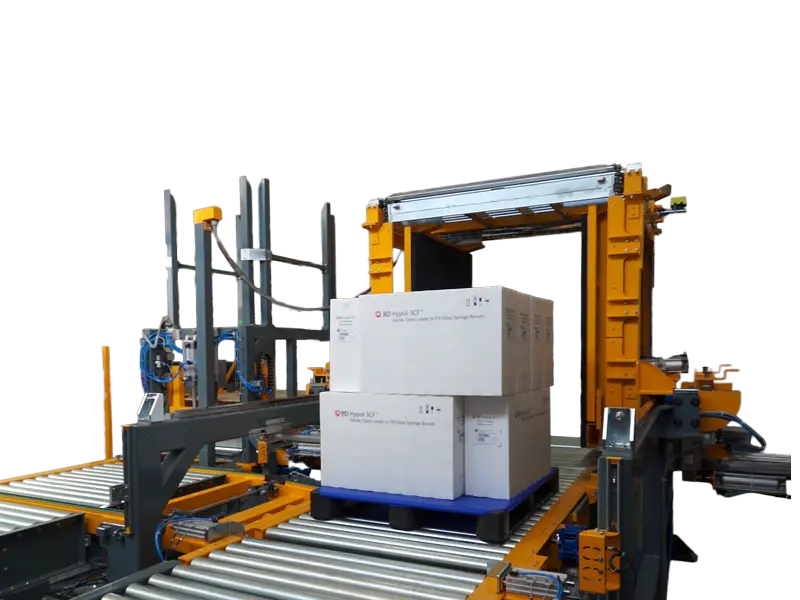Cutting Downtime in Italy: How Pallet Changing Machines Help
Your production lines are running at peak capacity. Your team is efficient. Yet, you are still experiencing frustrating bottlenecks at the very end of your process: the shipping bay. Damaged pallets bring everything to a halt. You need to switch from your in-house pallets to a customer's specific type, and the manual process is slow and dangerous. These small issues create significant delays that ripple backward through your entire operation. This final step, which should be simple, is constantly undermining your hard-earned productivity gains and costing you money. What if you could solve this problem? What if you could transfer a full load of your products from one pallet to another in about a minute, with minimal human touch? This is exactly what a pallet changing machine does. It directly attacks the root causes of end-of-line downtime, a lesson I saw transform a business firsthand on a trip to Italy.
A pallet changing machine cuts downtime by automating the entire process of transferring goods between pallets. This system eliminates the slow, labor-intensive, and risky task of manual restacking. It secures the product load, then tilts, inverts, or pushes it to allow for a quick pallet swap. This simple automation prevents product damage from faulty pallets and streamlines logistics, ensuring your operations keep moving without costly interruptions.
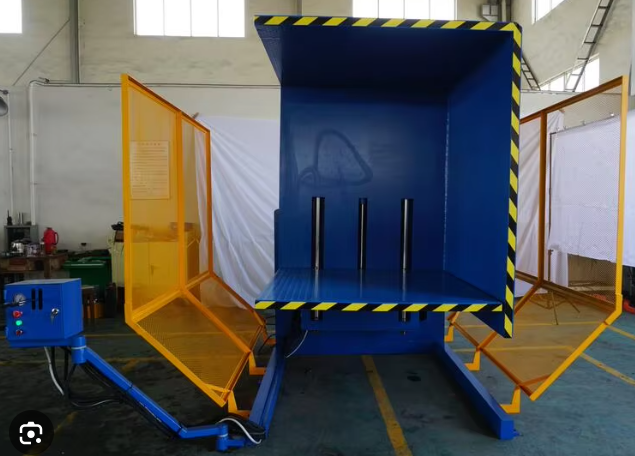
This might sound like a simple mechanical fix, but its impact on a business is profound. From my journey starting as a factory engineer to building my own company, SHJLPACK, I’ve learned that the biggest gains often come from solving these overlooked problems. It's not just about speed; it's about creating a more reliable, safe, and cost-effective process. Let's dig deeper into how this technology works. We will look at how it directly impacts manual labor, the financial sense it makes in high-cost markets like Italy, and how it fits into the modern, connected factories that leaders like you are building today.
How Does a Pallet Changer Directly Reduce Manual Handling Downtime?
You know the scene well. A forklift operator notices a broken pallet just as a load is about to be shipped. Everything stops. Two or three workers are pulled from their tasks to manually unstack and restack the entire load onto a new pallet. This process is slow, physically exhausting, and a prime opportunity for products to be dropped or damaged. Every minute spent on this manual workaround is a minute your production line is either halted or backed up. This single, unreliable step is a constant source of hidden downtime. A pallet changer completely removes this manual, time-consuming task. It transforms a 20-minute, multi-person job into a one-minute, single-operator, automated cycle.
A pallet changer directly reduces manual handling downtime by mechanizing the entire transfer process. Instead of people physically moving boxes, bags, or other goods, the machine securely clamps the load. It then either inverts the load 180 degrees or uses a pushing mechanism to slide it smoothly onto a new pallet. This automation drastically shortens the time required for a pallet exchange, removes the risk of worker injury, and all but eliminates product damage during the transfer.
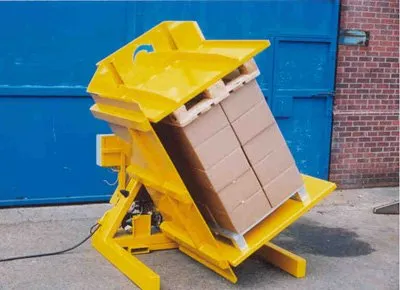
The Mechanics of Eliminating Wasted Time
To truly understand the impact, you need to see the difference in workflow. A manual pallet exchange is an unpredictable, multi-step process. An automated one is a precise, repeatable cycle. The machine streamlines the operation into a few simple, quick actions. This predictability is a huge asset for any operations manager trying to stabilize production flow.
| Feature | Manual Pallet Exchange | Automated Pallet Changer |
|---|---|---|
| Time Required | 15-30 minutes | 1-2 minutes |
| Labor Required | 2-3 workers | 1 operator |
| Risk of Injury | High (lifting, repetitive motion) | Very Low |
| Risk of Damage | Moderate to High | Very Low |
| Process Consistency | Low (depends on workers) | High (machine-controlled) |
I remember visiting a ceramic tile manufacturer near Modena, Italy. Their product was heavy and fragile. Their biggest challenge was moving tiles from their sturdy, in-house wooden pallets to higher-quality plastic pallets required for export. This was their main bottleneck. Manually, it took two workers almost 20 minutes for each pallet. Breakages were a regular, accepted cost of business. After we helped them install a pallet inverter, one operator could manage the entire exchange in about 90 seconds. Their shipping department's throughput increased by over 30% almost instantly. They were no longer held back by this slow, manual process.
Beyond Speed: Tackling Hidden Sources of Downtime
The most obvious benefit is speed, but the true impact on downtime is deeper. Think about the hidden costs of manual handling. A single back injury can take an experienced worker off the floor for weeks, causing staffing shortages and forcing you to train temporary replacements. That is a significant source of operational downtime. Damaged products don't just disappear; they require inspection, paperwork, and potential rework or remanufacturing, all of which consumes time and resources that should be focused on production. A pallet changer mitigates these risks. It creates a safer work environment, which reduces absenteeism and turnover. It protects your products, ensuring that what you produce gets shipped without costly delays. This transforms your end-of-line logistics from a point of weakness into a source of strength and reliability.
What Are the Key ROI Factors for Investing in a Pallet Changer in a High-Cost Environment like Italy?
You see the operational benefits, but any smart business owner needs to see the numbers. New equipment is a major capital investment. In a high-cost environment like Italy, where labor, energy, and real estate are expensive, you have to be certain that an investment will pay for itself. You cannot afford to purchase machinery that doesn't deliver a clear and rapid return on investment (ROI). You must justify every euro spent. The good news is that the ROI for a pallet changer is often much faster than people expect because it comes from several different areas of cost savings, not just one.
The key ROI factors for a pallet changer in a high-cost market are direct labor savings, increased throughput, reduced product damage costs, lower insurance premiums from fewer worker injuries, and the ability to optimize pallet inventory. For instance, you can use cheaper, lower-quality pallets for internal use and switch to high-quality export pallets only when needed. In expensive regions, these combined savings add up quickly, often resulting in a full payback period of 12 to 24 months.

A Practical Look at the Numbers
Let's break down the financial justification. When I work with clients, I help them build a business case by looking at all the numbers, not just the obvious ones. A pragmatic leader like yourself needs to see this clear breakdown. The analysis often reveals savings in areas that were previously considered just "the cost of doing business."
Here is a simplified ROI calculation framework:
| Savings Category | Calculation Example (Annual) | Potential Savings |
|---|---|---|
| Direct Labor Savings | (2 workers €25/hr loaded cost) (2 hours saved/day) * (250 work days) | €25,000 |
| Product Damage Reduction | (€500 in damaged goods/month) * (12 months) | €6,000 |
| Increased Throughput | (10 extra pallets/day €50 profit/pallet) (250 work days) | €125,000 |
| Pallet Inventory Savings | (2,000 pallets/month €10 saved/pallet) (12 months) | €240,000 |
| Injury Cost Reduction | (Reduced insurance premiums + avoided downtime) | €5,000 - €15,000 |
Note: These numbers are illustrative examples. Your actual savings would depend on your specific operational costs and volumes.
This calculation shows how the investment pays for itself from multiple angles. For the Italian tile manufacturer I mentioned, the biggest driver was a combination of labor savings and pallet cost optimization. They were able to almost completely eliminate their inventory of expensive export pallets, buying them just-in-time and immediately transferring goods for shipment. The capital they freed up was significant.
The Intangible, Yet Valuable, Returns
Beyond the hard numbers, there are other returns that are harder to quantify but are just as important for a forward-thinking leader. When you automate a physically demanding and dangerous job, employee morale improves. You show your team that you value their safety and well-being. This can lead to lower turnover and a more engaged workforce. Your facility also looks more modern and professional to visiting clients, reinforcing your brand's commitment to quality and technology. Furthermore, it ensures you are compliant with increasingly strict manual handling and workplace safety regulations in Europe. This reduces legal and financial risk. These intangible benefits contribute to a healthier, more resilient, and more competitive business in the long run. They are a core part of the total return on your investment.
Can Pallet Changers Integrate with Existing Warehouse Management Systems (WMS)?
You’ve spent years and significant capital developing your digital infrastructure. Your factory likely runs on a Warehouse Management System (WMS) or an Enterprise Resource Planning (ERP) system to coordinate everything from raw materials to final shipping. The last thing you want is a new machine that acts as a standalone "island of automation." A machine that cannot communicate with your central system is not a solution; it's a new problem. It creates a break in your digital workflow and forces your team back to manual data entry and verbal commands, undoing the very efficiency you seek. Fortunately, modern packaging and handling equipment is built for a connected world. A pallet changer is designed to be a fully integrated node in your smart factory, not an isolated piece of metal.
Yes, modern pallet changers are designed to integrate seamlessly with existing WMS and ERP systems. They achieve this using standard industrial hardware and software, such as PLCs (Programmable Logic Controllers), sensors, and communication protocols like PROFINET, EtherNet/IP, or OPC UA. This allows the pallet changer to receive commands from the WMS, execute tasks automatically, and report back on its status and performance, making it a true component of your automated and data-driven logistics operation.
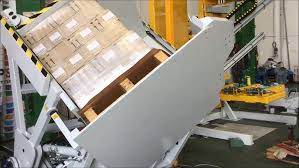
Building the Digital Bridge: How Integration Works
Connecting a pallet changer to your WMS is more straightforward than you might think. From my engineering background, I know the details matter. The machine's brain is its PLC. This PLC acts as the bridge to your larger system. The integration can be as simple or as complex as your operation requires. For example, an AGV (Automated Guided Vehicle) can transport a pallet to the infeed conveyor of the pallet changer. A barcode scanner reads the pallet ID and sends it to the WMS. The WMS checks its database and sends a command back to the pallet changer's PLC: "This is product SKU 501. Transfer it to a 1200x1000mm plastic pallet." The pallet changer then executes the entire cycle automatically. Once complete, it sends a confirmation message back to the WMS: "Task complete. Pallet #XYZ123 is ready for pickup." Your system then dispatches another AGV or alerts a forklift operator for retrieval. This creates a closed-loop automated process with no manual intervention.
Data: The Real Power of Integration
This connection is about more than just commands. For a leader focused on digital transformation, the real value lies in the data. An integrated pallet changer becomes another valuable sensor on your factory floor. It provides a constant stream of data that can be fed into your Manufacturing Execution System (MES) or analytics platform. You can track key performance indicators (KPIs) like:
- Number of pallets changed per hour/shift/day
- Average cycle time
- Machine uptime and downtime
- Error codes or fault alerts
This data gives you complete visibility into the performance of your end-of-line logistics. You can identify patterns, pinpoint inefficiencies, and make data-driven decisions to further optimize your processes. This is how you achieve the goal of total production visualization. It’s no longer a guess; you know exactly how your shipping department is performing.
From Standalone to Fully Automated
Integration isn't an all-or-nothing proposition. It can be scaled to your needs.
- Level 1: Standalone. The machine is operated by a worker using a simple push-button control panel. It solves the manual handling problem but is not connected to a WMS.
- Level 2: Semi-Automated. The machine receives commands from a WMS via a terminal but is still loaded and unloaded by a human operator in a forklift. This eliminates data entry errors.
- Level 3: Fully Automated. The pallet changer is part of a conveyor or AGV system. It receives commands and operates without any direct human interaction, becoming a key component of a "lights-out" logistics operation.
As a solutions provider, my goal is to help you find the right level of automation for your current needs and your future goals. We can start simple and build towards full integration as your digital strategy evolves.
What Maintenance Strategies Maximize the Uptime of a Pallet Changer?
You are making an investment in a machine specifically to reduce your downtime. The ultimate irony would be for that very machine to break down and cause a new, unexpected stoppage. A non-functional pallet changer can bring your entire shipping operation to a standstill just as effectively as a broken pallet. It becomes a single point of failure. Therefore, ensuring its reliability is not an afterthought; it is a critical part of the initial plan. Like any essential piece of industrial equipment, the uptime of a pallet changer is directly related to a smart and consistent maintenance strategy. It's about being proactive, not reactive.
To maximize the uptime of a pallet changer, you must implement a multi-layered maintenance strategy. This strategy should include routine preventive tasks performed by operators, scheduled maintenance by trained technicians, and ideally, condition-based monitoring using sensors to predict failures before they happen. Keeping a small inventory of critical spare parts on hand is also a key part of this proactive approach to ensure the machine runs reliably day after day.
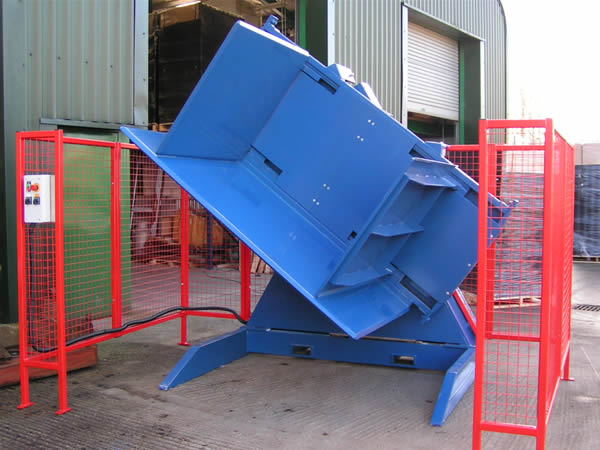
The Pyramid of Maintenance Excellence
A robust maintenance plan has several layers, each building upon the other. Ignoring the base layers and only reacting to failures is the surest way to experience costly, unplanned downtime.
Level 1: Operator Care (Daily/Weekly)
This is the foundation of reliability. Your machine operators are the first line of defense. They should be trained to perform simple, daily checks.
- Cleaning: Wiping down sensors and photo-eyes to ensure they function correctly.
- Inspection: A quick visual check for any loose bolts, hydraulic leaks, or frayed wires.
- Listening: Noting any unusual sounds like grinding or squealing that could indicate a developing problem.
This takes only a few minutes per shift but can catch over 80% of potential issues before they become serious problems.
Level 2: Preventive Maintenance (Scheduled)
This involves scheduled tasks performed by your in-house maintenance team or a certified technician. These tasks are based on the manufacturer's recommendations and the machine's usage.
- Lubrication: Greasing bearings, chains, and other moving parts.
- Fluid Checks: Inspecting and topping off hydraulic fluid levels.
- Calibration: Ensuring clamps and sensors are aligned and functioning correctly.
- Component Checks: Inspecting wear parts like hydraulic hoses and motor brushes.
Level 3: Predictive Maintenance (The Goal for 95%+ Uptime)
This is the top of the pyramid and is essential for achieving the highest levels of operational availability. This is where modern machines, equipped with IoT sensors, truly shine. Instead of waiting for something to break or replacing parts on a fixed schedule, you use data to predict failures. For example, a vibration sensor on the main motor can detect a subtle change that indicates a bearing is starting to fail. The system can then send an alert to the maintenance manager: "Motor 1 vibration has increased by 15%. Recommend inspection and replacement within the next 7 days." This transforms your maintenance from a reactive or scheduled cost into a proactive, strategic advantage. It allows you to schedule repairs during planned downtime instead of suffering a catastrophic failure during peak production.
Choosing a Partner, Not Just a Supplier
When I built my own factory, I learned a crucial lesson: the relationship with an equipment provider is most important after the sale is complete. This is the core philosophy I built into SHJLPACK. When you evaluate a pallet changer, you should be evaluating the company behind it. Ask them tough questions. What does your after-sales support look like? Do you provide a recommended list of critical spare parts to keep on-site? Can you provide remote diagnostic support by logging into the machine's PLC from your office? A true partner is as invested in your uptime as you are. They provide the training, documentation, and expert support needed to make your maintenance strategy successful. This partnership is the key to ensuring your machine delivers value for years to come.
Conclusion
A pallet changer is more than just a machine. It is a strategic tool to cut downtime, lower operating costs, and push your facility towards a more automated and efficient future.

